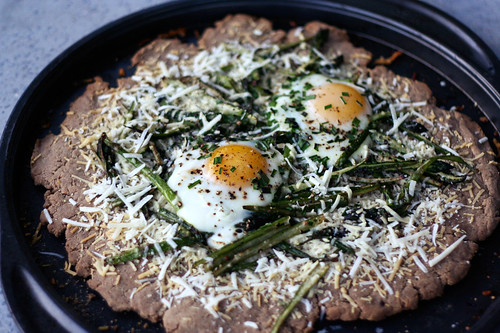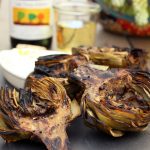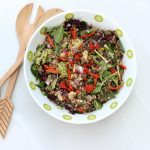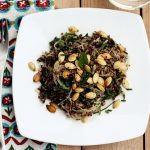I’ve been using the same gluten-free pizza dough recipe for sometime now and though I do like it, I wanted to try something a little different and without the gums. I came across this recipe on Gluten Free Girl and The Chef a while back and when I saw that it contained no gums and it was flexible with the flours you can use, I was very intrigued. Shauna has a formula she created to make your own gluten-free all-purpose flour without gums and by weight instead of volume, plus it is very easy to make it a whole-grain mix by using different flours. Here is the original post about their pizza recipe that they changed a bit since their book came out. There are a few different flours you can choose from if you have sensitivities to things like corn or potato. I used their whole grain flour mixture that they featured in their post for whole grain muffins. I don’t have a ton of experience with baking, it is something I have only learned to love in the last year or so, but with the little bit I have done, I find that weighing your dry ingredients as opposed to measuring really gives you a consistent result, time and time again.
I decided a nice way to try out this new pizza dough recipe was to really let it shine, by not loading it with ingredients and sauces. I wanted a simple, tasty spring pizza that featured asparagus and eggs. The only thing I may change next time would be to use some mozzarella in addition to the parmesan to give it a bit more melty of a cheese base since the parmesan tends to not get super melty, however the dough was so delicious it honestly didn’t need it. Overall it was full of flavor from the asparagus and the fresh chives and the eggs were a wonderful compliment on top. The runny yolk was perfect for dipping the delicious crust into. You’ll be so surprised when you taste this crust at how it tastes just like real pizza crust – you’ll never know it’s gluten-free.
I know this post is large and contains a lot of info – but I promise it is all worth reading through. I am happy to finally have a good all-purpose flour mix to have on hand for different things and an even better pizza dough recipe. Play around with different toppings and flour combinations and please feel free share, I’d love to hear what you come up with.
GLUTEN-FREE GIRL’S ALL-PURPOSE FLOUR MIX
Here is the original information on the all-purpose flour mix (all content and info contained in both the flour mix and the pizza recipes is copyright of Gluten Free Girl and The Chef)
Want to make a whole grain AP mix in your kitchen? Here’s how.
We’re working with 70% whole grains/30% starches. We might someday go to all whole grains for some baked goods, but this blend works well for us now.
If you want to make a big batch for all the baking in your kitchen?
Choose 700 grams of any combination of the following flours:
Almond
Amaranth
Brown Rice
Buckwheat
Corn
Millet
Oat
Quinoa
Sorghum
Sweet Brown Rice
Teff
Almond is not a grain, but it is a whole flour, so I’ve thrown it in there. You might notice that I have not put in garbanzo (I don’t like it) or coconut (I don’t like the way it tastes or the way it sucks all the moisture out of a baked good) or soy (I’m having a hard time finding a good gluten-free one). You might like those. Substitute if you want.
This means that you can make your own blend. If you are allergic to corn, and you know you can’t eat the certified gluten-free oats, blend up 100 grams each of almond, brown rice, buckwheat, corn, millet, sorghum, and teff. (I want to write more about this later, but the flavor you find by blending all these different taste is fascinating. It’s amazing how boring regular AP flour seems after you use this.) Find your own favorite combination.
And then throw in 300 grams of any combination of the following:
Arrowroot
Cornstarch
Potato Starch
Tapioca Flour
White Rice Flour
We like using 150 grams each of arrowroot and potato starch, at the moment.
Combine the 700 grams of whole-grain flours with the 300 grams of starches in a big container. Shake it all up. You have whole-grain flour mix.
———————————————————————————————————————————————————-
For my AP mix I went with 175 grams each of Almond, Millet, Sorhum and Teff flours and 150 grams each of potato starch and tapioca flour. It was super simple to mix up and it made 1000 grams of all-purpose flour so I have enough to make pizza again.
The flours brought so much flavor to the crust and it was perfectly crispy on the outside and soft and chewy inside. This was by far the best crust I have ever made at home and it was simple. I’ve noticed that some gluten-free crusts get abnormally puffy and airy and don’t taste like usual pizza, others are so thin and crusty that it’s almost like eating a large cracker. I also really love
GLUTEN-FREE GIRL’S WHOLE GRAIN PIZZA CRUST
1 tablespoon ground flaxseed or ground chia seeds
500 grams whole-grain gluten-free flour mix
1 1/2 teaspoons kosher salt
15 grams (4 teaspoons) active-dry yeast
50 grams (1/4 cup) extra-virgin olive oil
85 to 190 grams (1/2 to 1 cup) warm water, about 110º
olive oil for brushing on top of the crust
Making the flaxseed or chia slurry. Mix the flaxseed (or chia seed) into a bowl. Pour 2 tablespoons of boiling-hot water over the seeds. Whisk immediately and quickly until you have a thick paste. Let this set aside and cool down.
Combining the dry ingredients. Put the gluten-free flours and the salt into the bowl of a stand mixer. Mix them up together.
Activating the yeast. Put the yeast, olive oil, and half the warm water into a small bowl. Stir gently. Let them sit for a moment to activate the yeast.
Making the dough. Add the slurry to the dry ingredients and mix for a moment. Pour the yeasty water into the dry ingredients. With the mixer on medium, whirl for a few moments, until the dough comes together into a soft ball around the paddle of the stand mixer and feels soft and pliable. If the dough feels too dry, add more of the warm water in small amounts until the dough feels right. (You might not need all the water. You might need more. Yeast doughs can differ from kitchen to kitchen.) Set the dough aside in a warm place and let it rise for 1 hour.
Preparing to bake. Preheat the oven to 450°. (If you feel comfortable with heat, take it up to 550°. Just watch the dough in the oven, carefully.) If you have a pizza stone, make sure it is in the oven. If not, sprinkle a pizza tray or baking sheet with gluten-free cornmeal.
Rolling out the dough. Grab 1/2 of the dough and put it between 2 pieces of parchment paper. Through the paper, roll out the dough to your desired thickness. (We like super-thin crust around here. You might like it thicker.)
Pre-baking the dough. Take the parchment paper off the dough, then transfer the dough to the pizza stone or prepared pizza tray. Brush the top with olive oil. Bake until the dough has started to crisp up and browned at the edges, about 8 to 10 minutes. (And less if you have the oven cranked up to 550°!)
Take the crust out of the oven. You now have a pre-baked pizza crust. Top with anything you fancy and continue baking until the cheese is bubbly and melty.
Makes 2 – 8-inch pizza crusts or 1 – 16-inch pizza crust. I went with 1 large round pizza. Don’t worry too much about the shape, enjoy the rustic wonkiness of handmade pizza dough.
SPRING PIZZA WITH ASPARAGUS, PARMESAN AND EGGS
Makes 1 large pizza or 2 small pizzas
Gluten-free Girl’s Whole Grain Pizza Dough Recipe (above)
Olive oil
Kosher flake salt
Black pepper
10 asparagus stalks
1 clove garlic, minced
1 – 1 1/2 cups freshly grated Parmigiano-Reggiano or mozzarella (or both)
1 bunch of fresh chives, chopped
2-4 local farm fresh brown eggs (I put 2 eggs on one large pizza, but you could certainly put 2 eggs each on 2 small pizzas)
Prepare dough according to above instructions (or whatever instructions come with your dough recipe). Preheat oven to 450ºF.
Rinse the asparagus, snap off the tough ends and cut in half or thirds depending on how long they are. You want to end up with 20-30 3-inch pieces. Take each 3-inch piece, cut in half on the long side, and then again to quarter. Heat a tablespoon of oil over medium-high heat , saute the asparagus slivers and the minced garlic with black pepper and a large pinch of kosher salt until tender and still bright green. Remove the asparagus from the heat and set aside.
Brush the pre-baked pizza crust (pre-bake according to above directions) with olive oil. Sprinkle the crust with the cheese, reserving a small amount for sprinkling on top. Arrange the asparagus in a single layer over the cheese. Crack two eggs into the center of the pizza, sprinkle fresh chopped chives over everything and top with another light sprinkle of cheese. (If you are making two small pizzas, divide all the ingredients in half over the two crusts and arrange in the same order)
Bake for about 10-15 minutes, or until the egg whites are cooked and the pizza is golden brown. Allow to cool slightly for a few minutes, then cut and serve while still warm.












